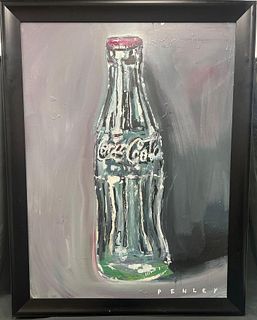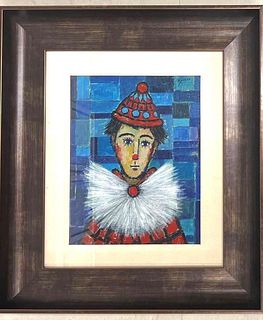Workshop of FRANÇOIS DE NOMÉ (Metz, c. 1593-Naples, c. 1644). "Lot and his family leaving Sodom." Oil on canvas. Relined.
Lot 32
About Seller
Setdart Auction House
Carrer Aragó 346
Barcelona
Spain
Setdart Subastas was born in 2004 and is currently the first online art auction in Spain with solidity, prestige and reliability guaranteed by our more than 60,000 users. Setdart has a young, dynamic and enterprising team ready to successfully manage the purchase and sale of art works through custom...Read more
Estimate:
EUR€5,000 - EUR€5,500
$5,376.34 - $5,913.98
Absentee vs Live bid
Two ways to bid:
- Leave a max absentee bid and the platform will bid on your behalf up to your maximum bid during the live auction.
- Bid live during the auction and your bids will be submitted real-time to the auctioneer.
Bid Increments
| Price | Bid Increment |
|---|---|
| EUR€0 | EUR€10 |
| EUR€200 | EUR€25 |
| EUR€500 | EUR€50 |
| EUR€1,000 | EUR€100 |
| EUR€3,000 | EUR€200 |
| EUR€5,000 | EUR€500 |
| EUR€10,000 | EUR€1,000 |
| EUR€20,000 | EUR€2,000 |
| EUR€50,000 | EUR€5,000 |
About Auction
By Setdart Auction House
Jun 1, 2021
Set Reminder
2021-06-01 09:45:00
2021-06-01 09:45:00
America/New_York
Bidsquare
Bidsquare : OLD MASTERS & SCULPTURE - Day 2
https://www.bidsquare.com/auctions/setdart-auction-house/old-masters-sculpture---day-2-6999
Setdart Auction House sofia@setdart.com
Setdart Auction House sofia@setdart.com
- Lot Description
Workshop of FRANÇOIS DE NOMÉ (Metz, c. 1593-Naples, c. 1644). "Lot and his family leaving Sodom." Oil on canvas. Relined. Measurements: 59 x 84 cm. We see in this canvas a magnificent landscape starring the city of Sodom in flames, the setting for the biblical episode of Lot and his daughters (Genesis 19). In this passage it is narrated that while Lot and his family are in Sodom, two angels arrive in Sodom and two angels arrive in Sodom. Two angels arrive in Sodom and Lot shows them great hospitality. However, the men of the city gather around Lot's house and ask him to give them the two guests so they can rape them. In response, Lot offers them his two daughters, and points out that they are virgins (verse 19: 8). The crowd rejects Lot's offer, but the angels warn Lot to leave the city before it is destroyed. During the flight Lot's wife becomes a pillar of salt, but Lot and his daughters escape to Zoar, and end up living in a cave in the mountains. Seeing that their inevitable fate is going to be loneliness, they decide to get their father drunk and have sex with him, in order to become pregnant. Iconographically, the flight of Lot and his daughters was a theme that began to be represented during the sixteenth century, being chosen in its representation by great artists such as Lucas Cranach, Tintoretto and Rubens. François de Nomé is still linked today to the name of Monsù Desiderio; a designation with which the works of two different artists have traditionally been associated: François de Nomé and Didier Barra. Both painters, whose personalities have recently been separated and identified, were natives of Metz and were active in Naples during the first half of the 17th century, even working in collaboration. François de Nomé moved to Rome when he was about eleven years old. There he trained with Master Baldassarre, who was probably the Flemish landscape painter Balthazar Lauwers, also known as Lauri. In addition to the imprint of Lauwers' own work and that of Paul Bril, François de Nomé's work is influenced by the extravagant architectural painting of Hans Vredeman de Vries and the theatrical scenes of Jacques Callot and Giulio Parigi. From 1610, De Nomé is documented in Naples, where he remained until the end of his life. By the end of the 1610s his work had already acquired a certain reputation, receiving around 1618 his first major documented commission: a cycle of twelve paintings on the theme Stories from the Life of Pharaoh, now unaccounted for. François de Nomé's production is characterized by the small format, towards which he has a preference, and by a very pasty application of color. His chronology is not easy to fix, since only a few pieces of his production are dated, being the reading of these digits difficult to interpret. In the paintings attributed to him, two themes predominate: on the one hand, perspective views of streets and churches and, on the other, ruins and fantastic architectures profusely decorated, which serve as a background for small biblical scenes. The figures that populate his views were often the result of collaboration with other artists, among them Belisario Corenzio and Jacob van Swanenburgh.
- Shipping Info
-
In-house shipping available. Please inquire at admin@setdart.com.
-
- Buyer's Premium



 EUR
EUR CAD
CAD AUD
AUD GBP
GBP MXN
MXN HKD
HKD CNY
CNY MYR
MYR SEK
SEK SGD
SGD CHF
CHF THB
THB

















